Forearm Muscle Pain
When you feel pain during hand and arm activity, it is may indicate forearm muscle pain. This pain is highly disruptive to the everyday life of the patient. This pain results from different causes and each cause is requiring a different therapy approach.
What is forearm muscle pain?
- The forearm is composed of the radius and ulna bones, which span the length of the forearm and intersect at the wrist joint.
- Many muscles are in the forearm which acts the hand and arm movement.
- If any injury occurs in the arm and hand it leads to forearm muscle pain.
- As a result of the forearm muscle injury and if the patient feels pain in the forearm which is a wide-ranging effect on mobility and interferes with daily functioning.
- When the forearm pain occurs, the patient feels a problem typing on a keyboard and gripping an item with the help of a hand.
- In most cases, a person is manage the forearm pain with rest and structured activity.
- This muscle pain is relieved by exercise and electrotherapy.
Muscles of the forearm:
The forearm muscles are located into two compartments:
- Anterior Compartment
- Posterior Compartment
Anterior Compartment of the Forearm Muscle:
The anterior compartment of the forearm muscle is further divided into three parts depending on the layer of muscle
Superficial muscles:
- Flexor carpi ulnaris
- Flexor carpi radialis
- Palmaris longus
- Pronator teres
All muscles arise from a common tendon, which originates from the medial epicondyle of the humerus bone.
Intermediate muscle :
Flexor digitorum superficialis.
This muscle has 2 heads- one head arises from the medial epicondyle of the humerus bone and the other head arises from the radius bone.
Deep muscles :
- Flexor pollicis longus
- Pronator quadratus
- Flexor digitorum profundus
This anterior compartment muscle group is conduct the pronation of the forearm, flexion of the wrist joint, and flexion of the fingers.
This anterior compartment muscle group is mostly innervated by the median nerve and receives the arterial supply from the ulnar artery and radial artery.
Posterior Compartment of the Forearm Muscle:
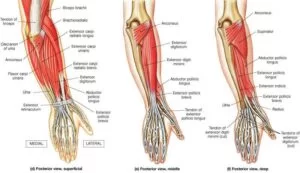
The muscles of the posterior compartment of the forearm are generally known as the extensor muscles.
The general function of the posterior compartment of the forearm muscles is to produce extension at the wrist joint and fingers.
This posterior compartment of the forearm muscles is innervated by the radial nerve.
The posterior compartment of the forearm muscle is further divided into two parts depending on the layer of muscle
Superficial Muscles:
- Extensor carpi radialis brevis
- Extensor digitorum
- Extensor carpi ulnaris
- Extensor digit minimi
- Brachioradialis
- Extensor Carpi Radialis Longus and Brevis
Deep Muscles:
- The supinator
- Abductor pollicis longus
- Extensor pollicis brevis
- Extensor pollicis longus
- Extensor indices.
Causes of the forearm muscle pain
Forearm muscle pain is caused by injury, nerve entrapment, and arthritis.
Injury:
When to occur acute trauma, like a fall which is become to causes a fracture in one of the forearm bones and injury to the ligaments and tendons.
Overuse:
Some sports, like tennis and specific types of weightlifting, when put a high degree of pressure on the muscles in the forearm which is lead to strain.
When extreme use of computers also occurs muscle strain in the forearm, which is known as repetitive strain injury ( RSI ).
This pain increases in RSI ( repetitive strain injury ) which is become common in the workplace and mostly occurs growth of computer-based labor.
Forearm muscle tightness due to inactivity of hands especially after an injury.
Nerve entrapment:
When the nerves become too compressed, which is produced pain, numbness, or a tingling feeling in and around the affected area.
Nerve entrapment is caused by a range of various syndromes which is affecting the forearm muscle.
The most typical nerve entrapment syndrome is carpal tunnel syndrome which is become to generate by forearm muscle pain.
Arthritis:
Arthritis occurs in the wrist and elbow joint, which produces a dull ache and pain in the forearm muscle.
An underlying condition:
Specific medical conditions, like angina, which is produced by pain in the forearm.
The forearm muscle pain is due to sports injury and inflammation in the forearm muscle.
This forearm muscle pain is also related to an infection, a nerve problem, growth, and even cancer.
some other conditions which are produced forearm muscle pain include:
- Sports injuries
- Tendinitis
- Dislocation
- Overuse injury
- Bone fracture
Symptoms of the forearm muscle pain
- Forearm muscle injury symptoms is depending on the underlying disease and condition.
- The patient feels weakness in the forearm muscle.
- The patient also presents redness, warmth, and swelling in the place of pain.
- Reduced mobility means a range of motion ( ROM ) of the elbow and wrist joints.
- The patient feels the shoulder, arm, hand, and finger means the entire upper limb pain.
- Tenderness is also present in the pain region.
- Sometimes present to possible deformity of the elbow and wrist joint.
- The patient feels numbness and a tingling sensation in the arm.
- Sometimes occur skin discoloration like as bruising.
In which condition instantly contact to doctor for this muscle pain?
In some cases, forearm pain occurs with the other symptoms which is indicate a severe condition so evaluated immediately in the emergency setting.
In the immediate condition that needs medical care call 911 for treatment.
Some severe conditions which need to doctor immediately basis:
- When the bone is puncturing out of the skin.
- If occur to extreme bleeding in the forearm.
- Paralysis of the forearm muscle.
- If the patient feels sudden and severe pain in the forearm.
Treatment for the forearm muscle pain
RICE principle:
In the initial phase of muscle pain used to the RICE principle is:
rest ( R ): Reducing the activity involving the forearm which helps the injured tendon, ligament, muscle, bone, and nerve to recover. The individual is to do the rest sometimes rather than remaining inactive for sustained times.
If the person presents with sports-related forearm pain avoid the sport till the pain is subsided.
Ice ( I ): Used to ice on the area of pain for 15 to 20 minutes which is help to decrease inflammation and pain. you can is also used an ice pack and frozen peas to release the pain.
Compression ( C ): In cases whereby movement is very painful, a person is required to splint and sling to restrict the activity and minimize pain.
Elevation ( E ): Elevate the arm with the help of a pillow decrease to swellings.
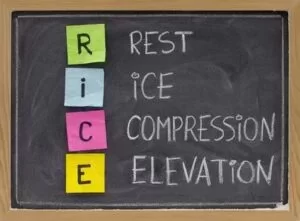
Medication for pain relief:
Your doctor prescribes pain reliever medicine mostly NSAIDs such as Ibuprofen and other anti-inflammatory medicines used to manage pain.
You have also used pain reliever gel & patches such as gel and volini gel for pain relief.
Hot therapy:
You are also trying to heat therapy on the swelling site which also reduces the pain.
You applied a hot pack to the site of pain to reduce the spasm and swelling.
Physiotherapy treatment for forearm muscle pain
In physiotherapy, treatment includes pain relieving modalities such as Transcutaneous electrical nerve stimulation (TENS), Interferential therapy (IFT) and Ultrasound that helps to relieve pain while stretching and strengthening exercise which is designed to rehabilitate and strengthen the forearm slowly.
Strengthening exercise the forearm muscle pain:
This strengthening exercise helps you strengthen the muscle of the forearm and decrease the weakness of the forearm.
- Palms-up wrist curl
- Palms-down wrist curl
- Grip crush
- Wrist dumbbell curls
- Farmer’s walks
- Pinch-grip plate holds
- Reverse barbell curl with the thumb-less grip
Palms-up wrist curl:
The patient’s position is sitting position resting the wrist joint on the knee joint and a flat surface, with the palms facing up.
The patient is maintaining a dumbbell in each hand.
After then raise the hands as high as possible, keeping the arms still, but the wrist joint should not rise off the surface means the wrist joint is in a resting position, after a slight pause, lower the hands into the starting position.
Palms-down wrist curl:
The patient’s position is sitting position resting the wrist joint on the knee joint and a flat surface, with the palms facing up.
The patient is to maintain a dumbbell in each hand, raise the hands as high as the patient can, and must keep the arms still, but the wrist joint does not rise off the surface means the wrist joint is in a resting position.
After a slight pause, back the hands to the starting position.
Grip crush:
The patient’s position is in a sitting position and rests the left wrist joint on the knee and a flat surface, with a holding dumbbell.
Then relax and open the hand so that the dumbbell rolls toward to fingertips.
Tighten the hand and curl the wrist up and squeeze the weight as tightly as possible.
After performing the 10 repetitions and repeat on the opposite side.
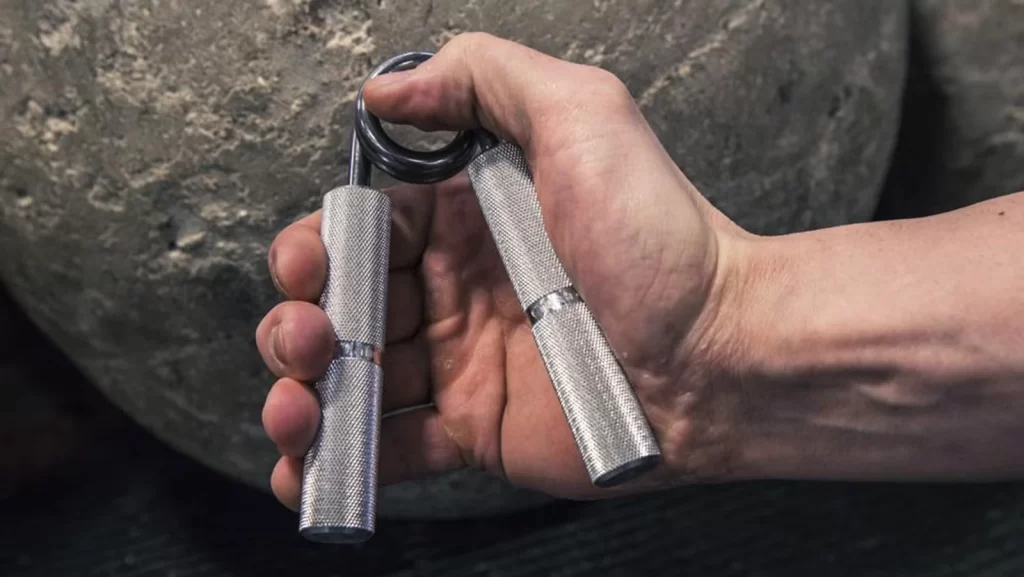
Wrist dumbbell curls:
The patient’s position is in a sitting position on a bench and chair then holding a moderately heavy dumbbell in each hand.
Then put the forearms on the thighs, so that the wrists are on top of the knees, and the palms are facing up and down.
Then slowly lower the weights as far as the patient can, and then Grip the weights tightly and move only the hands.
Curl the weights up as far as the patient can, and then back to the starting position.
Repeat this exercise 3 sets of the 12 repetitions till the muscles are done.
Alternatively, do one side at a time.
Farmer’s walks :
The patient’s position is in a standing position tall and holding a pair of heavy dumbbells and kettlebells at the sides.
After then slowly walk from one end of the workout space to the other end and back.
This exercise aims to do this Farmer’s walk exercise for 30 to 45 seconds per set.
Then do the Rest, and repeat this exercise 2 to 3 times every day.
Pinch-grip plate holds :
The patient’s position is straight fingers, pinch and hold a relatively heavyweight plate between the thumb and 4 fingers of the hand.
But this exercise is done one side at a time.
Maintain this position for 30 to 45 seconds per set and as long as the patient can.
Then do the Rest, and repeat this exercise 2 to 3 times every day.
Reverse barbell curl with the thumb-less grip:
The patient’s position is in a standing position then holding a barbell with the palms facing down and hands shoulder distance apart. Keep the thumb alongside the rest of the fingers for a “thumbless grip”, and keep the elbow joint close to the sides then slowly bring the barbell toward the shoulders.
After then Work on flexing only at the elbow joint to focus on the forearms.
Back into the starting position then move too slowly the entire time.
Then try to do the 3 sets of the 12 repetitions every day.
Some exercise helps you in reducing the pain:
- Elbow bend
- Wrist extension
- Elbow extension
- Wrist rotations
- Forearm squeeze
- Fingertip pushups
- Crab walk
- Plank with shoulder taps
- Isometric wall push
- Sphinx push-ups
- Pull-up bar hang
Elbow bend;
The patient’s position is standing up straight with the arms at the sides.
Flex the right arm upward and allow the inside of the hand to touch the shoulder joint.
If the patient can’t reach the shoulder, stretches only as close to it as the patient can, then maintain this exercise position for 15- 30 seconds.
Then lower the hand and repeat the exercise 10 times every day.
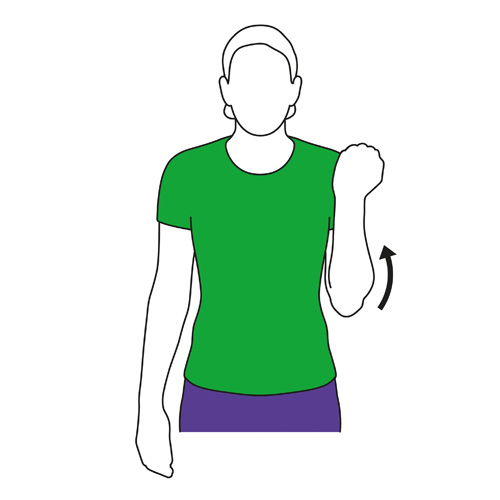
Wrist extension:
The patient position is in a standing position for to Wrist extension exercise, then extend the affected arm in front of the palm parallel to the ground.
With the help of the other hand, pull the wrist joint back toward the body, and then pull the wrist joint back till feeling a stretch in the forearm muscle but do not feel any pain.
Maintain this exercise position for 15 to 30 seconds and repeat the exercise 10 times every day.
elbow extension
The patient’s position is in a sitting position for the Elbow extension exercise.
Put the elbow on a table or chair arm, and using the other hand, gently push the forearm down towards the table or ground.
When feeling a stretch but without any pain, maintain this position for 15 seconds.
Repeat this exercise 10 times every day.
Wrist rotations:
The patient’s position is in a sitting position for the Wrist rotations.
The patient extended to arms in front of them with hands at shoulder height, and make a fist and rotate each wrist clockwise then anticlockwise in a circular motion.
Do this exercise 10 times in each direction in 1 session every day.

Forearm squeeze:
The patient’s position is to use a pair of forearm grips and another object to squeeze like a tennis ball or a sock.
Then extend and flex the fingers to squeeze the item.
Maintain this exercise for 3 to 5 seconds, then relax the grip for a few seconds.
Continue this exercise for 10 to 15 minutes at 1 time, and do this exercise 2 to 3 times every day.
Fingertip push-ups:
The patient’s position is kneeling by a bench and sturdy object and bringing the fingertips down on the surface.
Then slowly and with control, the patient brings the chest to the bench, and then bends the elbow joint at a 90-degree angle.
Then back to the starting position, and do this exercise in 2 to 3 sets of 8 to 12 repetitions.
Crab walk:
The patient’s position is coming into reverse tabletop position.
Put the hands under the shoulder joint, with the fingers facing toward your feet, and align the ankle joint directly under the knee joint.
After then walk forward on the hands and feet for up to 1 minute at a time.
perform this exercise 3 to 4 times every day.

Plank with shoulder taps:
The patient’s position is kneeling on the ground and on a yoga mat.
Put the hands directly under the shoulder joint – like a pushup position, then curl the toes under and raise the body into plank position.
Must steady the core muscle, lift the right hand from the ground and touch the other shoulder.
Then slowly back to the starting position.
Perform this exercise for 30 to 60 seconds and as the longer patient can, repeat this exercise 2 to 3 times every day.
Isometric wall push :
The patient’s position is a standing position in front of the wall with their hands on the wall, and keeping the arms straight but not locking the elbow joint.
Then press them firmly into the wall for 15 to 30 seconds, and after 30 seconds release the pressure, and repeat this exercise 2 to 3 times every day.
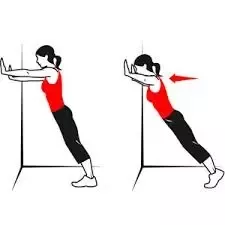
Sphinx push-ups :
The patient’s starting position is in a forearm plank position, either on the toes or on the knees.
After then press the hands down firmly and try to lift the forearms till the arms are straight.
Then, lower back down with the control.
If can not go all the way at first, just do an inch and 2 at a time.
Release the pressure, and repeat this exercise 2 to 3 times every day.
Pull-up bar hang:
The patient’s starting position is to grip the pull-up bar with the hands about shoulder distance apart, palm facing forward.
Hang for up to 15 to 30 seconds, with the arms straight and ankles crossed behind you.
After the release, repeat this exercise 2 to 3 times every day.
Then make it harder for this exercise: Wrap two small towels around the bar and grip the instead.
Stretching for forearm muscle pain:
- Wrist extensor stretch
- Forearm flexor stretch
- Supinator stretch
- Two-arm forearm stretch
- Praying forearm stretch
Wrist extensor stretch;
The patient’s position is in a sitting or standing position for the stretching, then hold the arm out parallel to the floor then extend from the shoulder.
After the turn the hand so it is facing downward.
Use the other hand which pulls the outstretched hand down and toward the body.
Flexing the wrist joint and feel a stretch on top of the hand and forearm, then slightly rotate the arm inward to feel a further stretch.
Maintain this stretching exercise position for 15 to 20 seconds.
Repeat this stretching exercise 5 times on both sides.

Forearm flexor stretch
The patient’s position is in a standing position for this stretching.
Put both arms out in front of the body with the elbow joint locked out, and then raise the palm of one hand like waving to a friend.
Then, with the opposite hand, gently pull the fingers toward the body.
Maintain this stretching exercise for 15-20 seconds.
Then repeat this stretching exercise on the opposite arm.
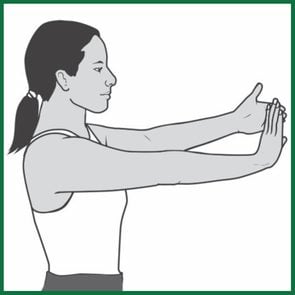
Supinator stretch:
The patient’s position is in a sitting position for this stretching.
Keep one end of a light dumbbell in the hand, then rest the arm, palm down, on a flat surface.
After then allow the dumbbell to rotate the hand just beyond neutral.
Maintain this stretching exercise for 15-20 seconds.
Repeat this stretching exercise 5 times on both sides.
Two-arm forearm stretch;
The patient’s position is to put the hands out in front of the body, the elbow joint locked out, and then internally rotate means medial rotation of the shoulder joint so that the backs of the palms are facing each other.
after then put one hand over the other hand and interlock all of the fingers.
Rotate the arms in the opposite direction as the arm is stretched, then with the non-working arm, push the wrist joint of the stretched arm into flexion.
Maintain this stretching exercise for 15-20 seconds and then repeat this stretching exercise on the other arm by switching to the top position.
Praying forearm stretch:
The patient’s position is in a Standing position and sitting upright in a chair.
Put the palms of the hands together without the interlocking of fingers, then raise both elbow joints so that the wrist joint begins to flex.
After then keep raising the elbow joint till feel a nice stretch in the undersides of the forearms.
Maintain this stretching exercise for 15-20 seconds.
Repeat this stretching exercise 5 times on both sides.

What is a home treatment for forearm pain?
- Resting the forearm which generally helps to reduce the degree of inflammation and swelling.
- Used Icing on the affected area with the cloth-covered ice pack for 10 – 15 minutes at a time which also helps to decrease the swelling.
- Taking over-the-counter pain-relieving medication, like ibuprofen (Advil) or acetaminophen (Tylenol), which is help to reduce pain and discomfort.
- Use a splint and bandage which limits mobility and also helps in healing.
Prevention of the forearm muscle pain
- Avoid movements which are put excessive strain on the forearm, like tennis and certain types of weightlifting.
- Taking to regular breaks from extended times of computer use and using an ergonomic keyboard at work.
- Perform the strengthening exercise of the forearm and increase the grip strength through resistance training.
FAQ
How do get rid of muscle pain in my forearm?
Flex your hand downward and gently pull it toward you using your other hand. You’ll feel the tension in your forearm and elbow. Maintain the stretch for 15 -30 seconds. Relax and back to the starting position and repeat the stretch with your opposite hand.
When should and be concerned about forearm pain?
You should be worried about your forearm pain if you feel like the underlying cause of the pain is a bone fracture, injured joints, or injured nerves. You should seek immediate medical treatment in case of a visual forearm bone fracture or hearing clicking, popping, or crunching connected to a forearm injury.
What does it mean when your forearm muscle hurts?
The causes of forearm pain often include sports injuries, overuse injuries, fractures, pinched nerves, and accidents. Forearm pain can also be related to a general infection, such as a cold, which generates body aches, or an infection of the tissues of the forearm itself.
How long does forearm pain last?
Inflammation should go away after 2 to 3 weeks of basic care. Severe or long-term cases of tendonitis often need complete rest of the forearm for a few days. You’ll also require to avoid activities that irritate the tendon for several weeks or months.
Do forearm muscles recover quickly?
However, while the forearms fatigue, they also heal quickly between sessions, which is exactly why this high-frequency daily training is suggested.
What is good natural muscle healing?
Glutamine is the most prevalent amino acid in the human body and delivers numerous benefits post-workout. One study found that glutamine increased muscle healing and reduced soreness. Glutamine is found in chicken, fish, spinach, dairy, and other foods. You can also get it as a supplement.

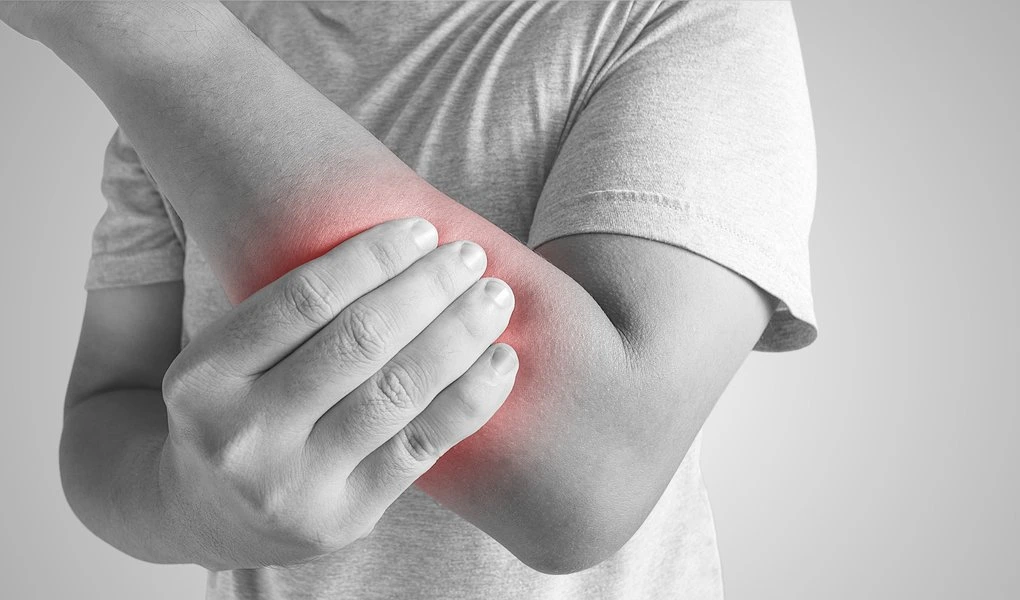
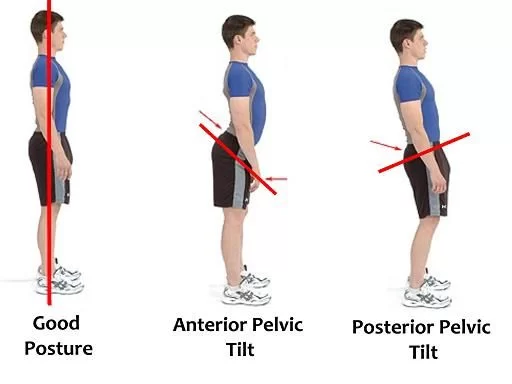
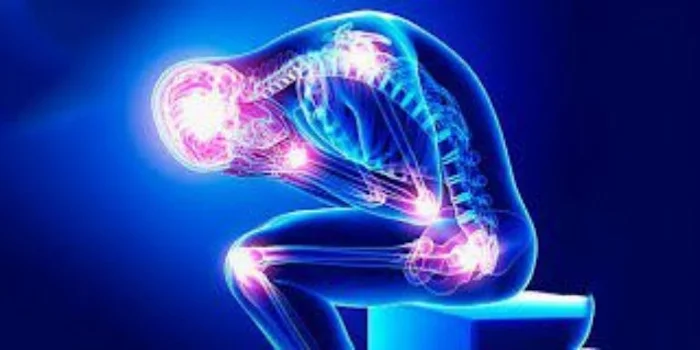
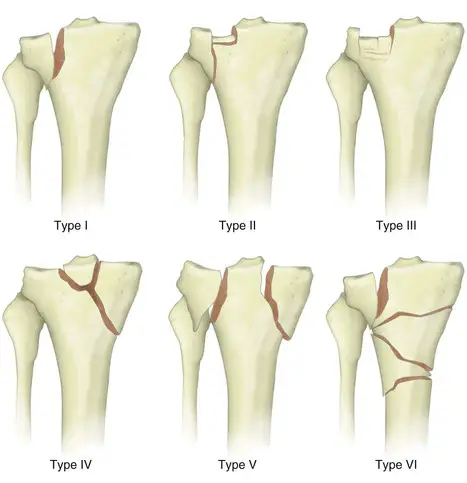
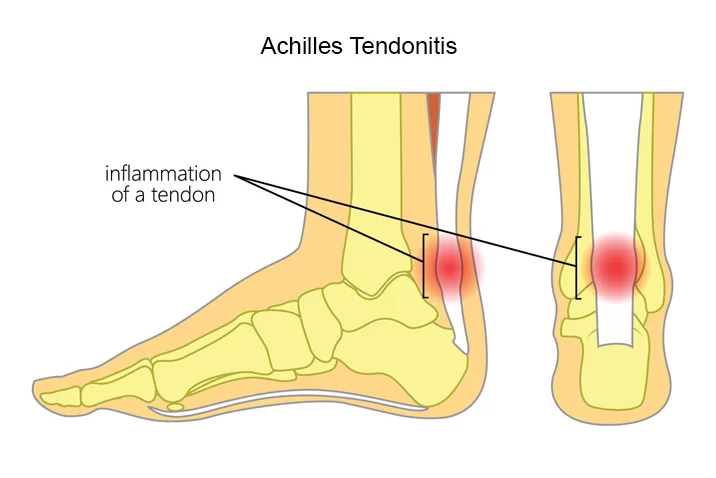
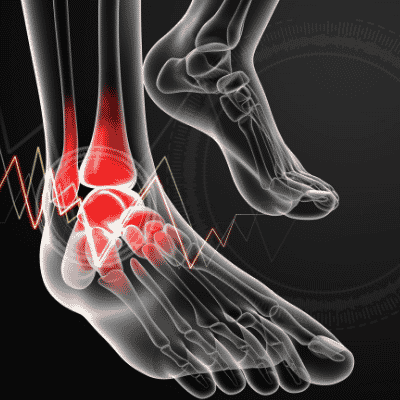
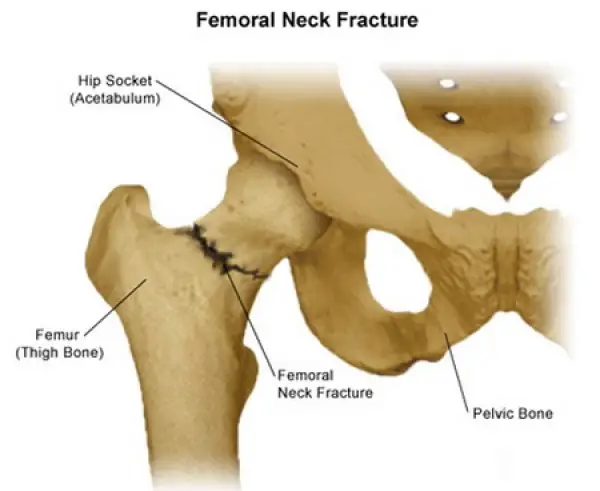
2 Comments